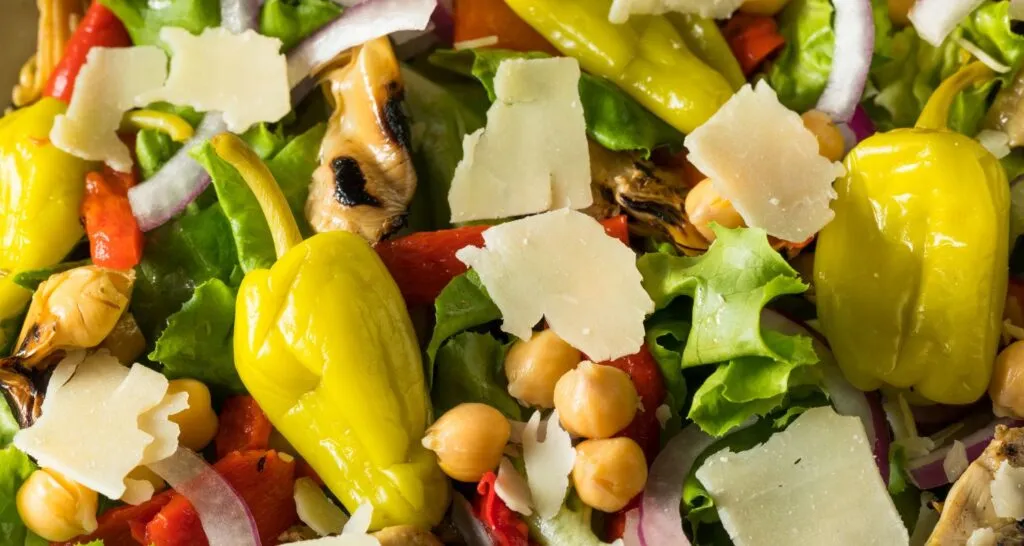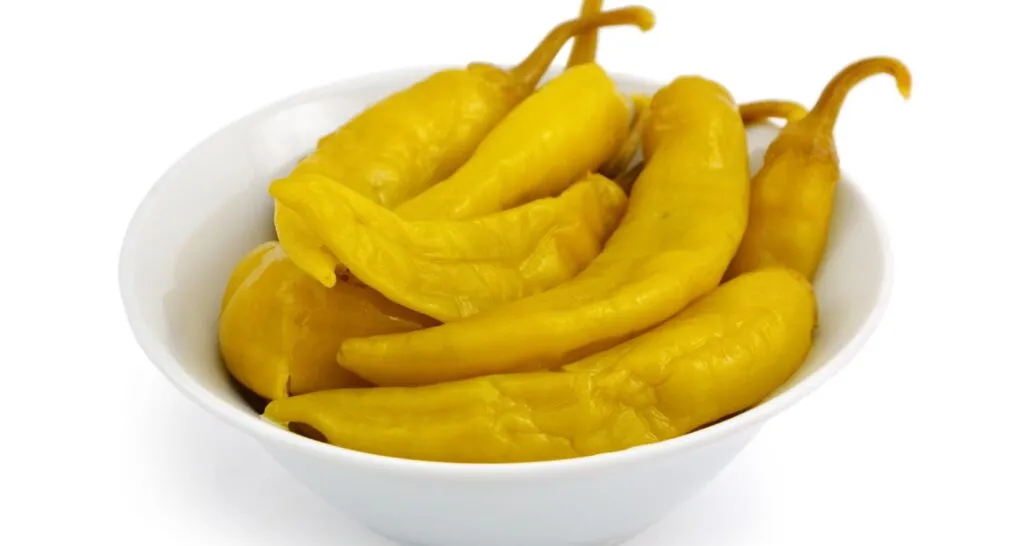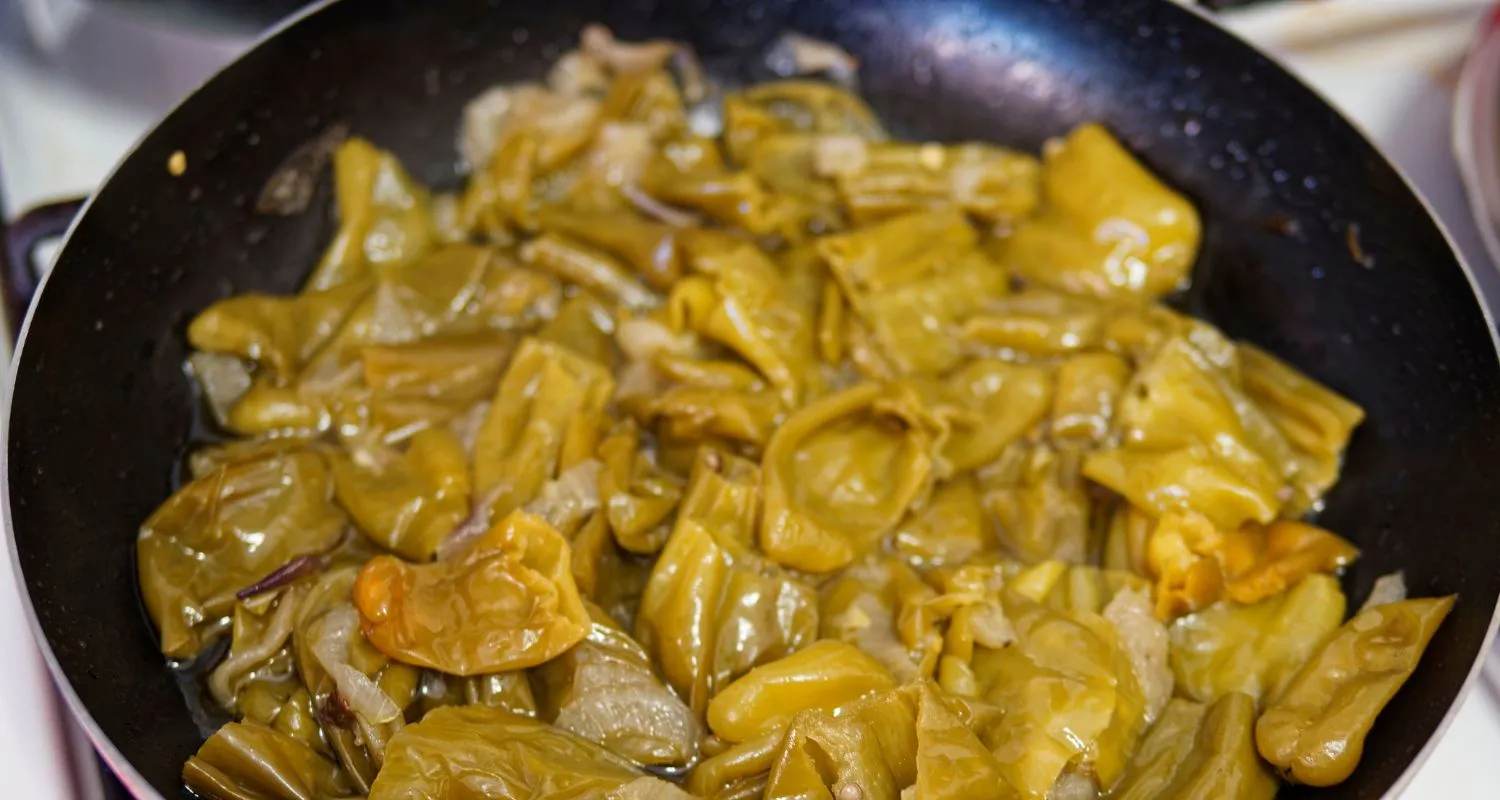In this deep dive, we explore the vibrant world of pepperoncini peppers, a staple in Mediterranean cuisine known for their tangy kick and health-boosting properties. From their origins to their place on the dinner table, these peppers have more to offer than just a bit of spice. We’ll walk you through how to grow them, their nutritional benefits, and even some scrumptious ways to incorporate them into your meals. So, buckle up! We’re about to embark on a spicy journey that promises to add a dash of flavor to your culinary adventures.
Introduction to Pepperoncini Peppers
Overview of Pepperoncini Peppers
Imagine a pepper that’s not just about the heat but also brings a tangy twist to the table. That’s the pepperoncini pepper for you! Originating from sunny Italy, these mild chilies have become a global favorite. With a Scoville heat rating that barely tickles the tongue, they offer a sweet, slightly spicy flavor that’s versatile in the kitchen.
Pepperoncini peppers, often picked while still green to yellowish in color, pack more than just flavor. They’re a sight to behold, with their slender, crinkled bodies that hint at the Mediterranean sun under which they grew. But it’s not just their looks or taste that makes them special; it’s their role in culinary traditions around the world that truly sets them apart.
History and Origin
Diving into the history of pepperoncini peppers, we find ourselves in the heart of Italy. Here, these peppers are more than just food; they’re a part of culture and tradition. Used to add zest to pizzas, salads, and sandwiches, they’ve been a staple in Italian kitchens for centuries. But their story doesn’t stop in Italy. Thanks to their irresistible flavor and ease of use, they’ve found their way into hearts and dishes across the globe.
Physical Description
Pepperoncini peppers are easily identifiable by their small size and bright, yellow-green hue. Typically 2 to 3 inches in length, they boast a curved shape that ends in a pointy tip. But don’t let their innocent appearance fool you. Inside, these peppers are bursting with a tangy flavor that can elevate any dish. Whether fresh or pickled, they’re a testament to the idea that great things often come in small packages.
In the culinary world, pepperoncini peppers shine bright. Their mild heat and unique flavor profile make them a favorite among chefs and home cooks alike. So, whether you’re looking to spice up your salad or add a zesty kick to your pizza, these peppers are your go-to choice. Now, let’s gear up to explore the many uses of these versatile peppers in our kitchens and gardens in the upcoming sections
Culinary Uses of Pepperoncini Peppers
When it comes to the kitchen, pepperoncini peppers are like a Swiss Army knife – versatile and handy in a pinch. Let’s unwrap the culinary potential of these tangy treasures.

How to Cook and Use Pepperoncini Peppers
First off, the magic of pepperoncini peppers lies in their ability to mingle with a variety of dishes. From a humble pizza to a sophisticated salad, they bring a zesty flair that’s hard to resist. But here’s a twist – have you ever thought about the pickled juice? That’s right, the brine in which these peppers soak isn’t just for kicks; it’s a secret ingredient waiting to dazzle in your dressings and marinades. Now, isn’t that something?
Cooking Methods
Whether you’re tossing them into a slow cooker for a tender pepperoncini beef or dicing them for a fresh Greek salad, these peppers adapt beautifully. They’re a dream in slow-cooked dishes, where they impart a gentle heat and tangy sweetness that permeates the meat. For a quicker fix, slice them up for a vibrant addition to pizzas and sandwiches. And let’s not forget, they’re fantastic pickled, offering a crisp, tangy bite that livens up any dish.
Recipes: Slow Cooker, Salads, Pizzas
Imagine your favorite dishes, now add a sprinkle of pepperoncini peppers – that’s the recipe for culinary magic. A slow cooker pot roast with pepperoncinis transforms into a melt-in-your-mouth experience, where the peppers add depth and tanginess. In salads, they introduce a spicy crunch that contrasts beautifully with creamy dressings or feta cheese. And on pizza? They’re the unsung heroes that deliver a punch of flavor with every bite.
For those eager to dive into the world of pepperoncini-infused dishes, exploring various recipes can unveil a treasure trove of flavors. Whether it’s a hearty beef stew enriched with the tangy essence of pepperoncinis or a vibrant salad that gets a spicy kick from these delightful peppers, the possibilities are endless. And let’s not overlook the simple joy of a pepperoncini-topped pizza, where the mild heat and tanginess perfectly complement the gooey cheese and savory toppings.
Tips for Using Pickled Pepperoncini Juice
But wait, there’s more! Don’t pour that pickled pepperoncini juice down the drain. It’s liquid gold in the kitchen, ready to elevate your marinades, dressings, and even cocktails. A splash of this briny, spicy liquid can transform a mundane dish into something extraordinary. It’s all about creativity and letting those tangy notes dance on your palate.
For those looking to further explore the culinary versatility of pepperoncinis, including how to harness the zesty power of their pickling juice, plenty of resources are available online. One such resource, Scoville Heat Units Chart, provides an engaging look into the world of peppers, offering insights that can inspire your next kitchen adventure.
In the realm of culinary creativity, pepperoncini peppers are a source of inspiration. Their ability to blend into a myriad of dishes while maintaining their distinct flavor profile makes them a favorite among food enthusiasts. So, why not let these tangy treats take your taste buds on a journey? The next section will spice up your knowledge even more as we delve into the health benefits and nutritional information of these zesty peppers. Stay tuned!
Health Benefits and Nutritional Information
Pepperoncini peppers are not just a treat for your taste buds; they’re also packed with nutritional benefits that can contribute to a healthy lifestyle. Let’s peel back the layers and discover what makes these tangy peppers a healthy choice.
Nutritional Value of Pepperoncini Peppers
First off, these peppers are a low-calorie delight, making them a perfect snack for those watching their waistline. But there’s more to them than just being low in calories. They’re bursting with vitamins and minerals, especially Vitamin C and A, which are essential for immune health and vision. Plus, their fiber content can help keep your digestive system running smoothly.
Pepperoncini peppers are a powerhouse of capsaicin, albeit in milder form compared to their fiery cousins. Capsaicin is known for its health benefits, including pain relief and boosting metabolism. So, while they might not make you break a sweat, they’re still working their magic on your well-being.
Capsaicin Content and Health Benefits
While pepperoncini peppers are on the milder side of the heat spectrum, the capsaicin they contain offers several health advantages. Research suggests capsaicin can play a role in fighting cancer, reducing inflammation, and even aiding in weight loss. It’s a compound that not only adds zest to your dishes but also contributes to your health in significant ways.
Capsaicin, the compound that gives peppers their heat, is not just about the spice; it’s a health booster too. Found in pepperoncini peppers, although in milder amounts, capsaicin is linked to several health benefits. It’s known for its ability to fight inflammation, offer pain relief, and even support weight loss efforts. Plus, it has potential anti-cancer properties, making these peppers a smart addition to your diet.
Vitamins and Minerals
Dive into the vitamin treasure trove that is pepperoncini peppers. Rich in Vitamin C, these peppers can help bolster your immune system, making you more resilient against common ailments. They’re also a good source of Vitamin A, essential for healthy vision and skin. And let’s not forget the minerals; these tangy treats provide a dose of potassium and iron, which are crucial for heart health and energy levels.
Fiber Content
Let’s talk fiber. Pepperoncini peppers are a great source of this essential nutrient, helping to promote digestive health and prevent constipation. Fiber also plays a role in managing blood sugar levels, making these peppers a smart choice for those looking to maintain a balanced diet.
For those interested in learning more about the health benefits of capsaicin and the nutritional value of pepperoncini peppers, resources like Health Benefits of Capsaicin provide comprehensive insights into how these components contribute to overall well-being.
Incorporating pepperoncini peppers into your diet is not just a way to add a splash of flavor to your meals; it’s also a step towards a healthier lifestyle. With their combination of vitamins, minerals, fiber, and capsaicin, these peppers offer a multitude of health benefits that can complement any diet. As we continue to explore the wonders of pepperoncini peppers, stay tuned for our next section, where we’ll delve into the art of growing these zesty beauties in your own garden.
Growing Pepperoncini Peppers
Growing pepperoncini peppers is a rewarding venture that adds zest to your garden and your meals. Let’s dig into the essential steps to cultivate these tangy delights right in your backyard.
When to Plant
Timing is everything when it comes to gardening. For pepperoncini peppers, the ideal moment to plant is after the last spring frost when the soil has warmed up. These heat-loving plants thrive in warm conditions, so ensuring the soil is adequately warm is crucial for their success.
Starting from Seeds vs. Buying Young Plants
You have two paths to bring pepperoncini peppers into your garden: starting from seeds or purchasing young plants. Starting from seeds can be more gratifying, offering the joy of watching your peppers grow from the ground up. However, for those looking for a head start, young plants from a local nursery can save time and offer a quicker route to harvest.
Preparing the Garden
A well-prepared garden is the foundation of a bountiful harvest. Begin by tilling the soil and enriching it with compost or slow-release fertilizer. This preparation ensures your pepperoncini peppers have all they need to grow strong and healthy.
Planting Instructions
Space is key for growing peppers. Plant seeds or seedlings about 18-24 inches apart to give them ample room to flourish. Bury the seeds about 1/4 inch deep in the soil, ensuring they have the perfect cover to sprout.
Ongoing Care
After planting, regular watering is vital to keep the soil moist but not waterlogged. Pruning can help maintain shape and encourage bushier growth. Also, keep an eye out for weeds that can compete with your peppers for nutrients.
Understanding and Dealing with Potential Pests and Diseases
Every gardener faces challenges, and pepper plants are no exception. Watch for pests like aphids and diseases like leaf spot. Early detection and organic insecticides can safeguard your plants, ensuring a healthy growing season.
Harvesting Your Pepperoncini Peppers
The moment of truth arrives about 70-80 days after planting when peppers turn from green to yellowish, signaling they’re ready for harvest. This stage captures their tangy flavor at its peak.
Using and Storing Your Homegrown Pepperoncini Peppers
Fresh from the garden, pepperoncini peppers can enhance salads, sandwiches, and more. For long-term enjoyment, pickling or freezing are excellent ways to preserve their tangy goodness.
For those looking to expand their gardening knowledge and dive deeper into the nuances of growing pepperoncini peppers, including tips on care and troubleshooting, visiting gardening forums or resources such as Gardening Tips for Beginners can offer valuable insights.
Growing pepperoncini peppers is not just about the harvest; it’s about the journey. From planting to picking, each step offers its own set of joys and challenges. As you tend to your garden, remember that patience and care are the true keys to a fruitful harvest. Stay tuned for our next adventure, where we’ll explore the myriad ways to incorporate these zesty peppers into your diet.
Pepperoncini Peppers in Diet
Incorporating pepperoncini peppers into your diet can be a flavorful way to enhance your meals while reaping health benefits. Let’s explore how these tangy peppers can fit into various dietary preferences.

Dietary Considerations
Pepperoncini peppers, with their low-calorie profile and nutritional punch, are perfect for anyone looking to add flavor without the guilt. Whether you’re following a Mediterranean diet, seeking to spice up your meals with low-calorie options, or simply enjoy a tangy snack, these peppers are a versatile choice. Their mild heat and distinct tang can complement any dish, making them a staple in health-conscious kitchens.
For those on a Mediterranean diet, pepperoncini peppers are a natural fit. Their tangy flavor pairs well with other staples of this diet, such as olives, tomatoes, and feta cheese, enhancing the overall taste and nutritional value of meals. Additionally, the antioxidants found in these peppers can contribute to the heart-healthy benefits associated with Mediterranean eating patterns.
Incorporating into Various Diets
Pepperoncini peppers can easily find their place in a variety of diets. For vegetarians and vegans, they add a spicy kick to plant-based dishes, enriching flavors without adding animal products. Low-carb and ketogenic diet followers can enjoy these peppers too, as their low sugar content makes them an ideal choice for adding flavor without compromising dietary goals.
Moreover, for those managing diabetes, the fiber content in pepperoncini peppers can help regulate blood sugar levels, making them a smart addition to a diabetes-friendly diet. Their vitamins and minerals also support overall health, contributing to a balanced and nutritious diet.
Whether you’re adding them to a salad for a crunchy, spicy element, tossing them into a pasta dish for a bit of tang, or simply snacking on them straight from the jar, pepperoncini peppers offer a versatile and healthful option for any meal.
In the quest for a balanced and flavorful diet, pepperoncini peppers emerge as a vibrant contender. Their ability to blend into various dietary preferences, coupled with their health benefits, makes them a worthwhile addition to any meal plan. As we continue to explore the wonders of these tangy peppers, remember that the key to a nutritious diet lies in variety and moderation. Stay tuned for our next section, where we’ll tackle common FAQs about pepperoncini peppers, providing valuable insights to pepper enthusiasts everywhere.
FAQs
Pepper enthusiasts often have questions about pepperoncini peppers, their uses, and their benefits. Let’s tackle some of the most common queries.
Common Questions and Answers
Q: Can I eat pepperoncini peppers raw?
A: Absolutely! Eating them raw is a great way to enjoy their crisp texture and tangy flavor. They can add a spicy kick to salads, sandwiches, and even pizzas.
Q: What are some popular substitutes for pepperoncini peppers?
A: If you can’t find pepperoncini peppers, banana peppers are a close substitute. They share a similar size, color, and tangy flavor but are slightly sweeter and less spicy.
Q: How can I store pepperoncini peppers to extend their shelf life?
A: Fresh pepperoncini peppers can be stored in the refrigerator, where they’ll keep for about a week. For long-term storage, pickling is an excellent option that can preserve them for several months.
Q: What’s the difference between pepperoncini and banana peppers?
A: While they’re often confused due to their similar appearance, the main difference lies in their heat level and sweetness. Pepperoncini have a slightly higher heat level and a more tangy flavor, whereas banana peppers are milder and sweeter.
Best Ways to Store and Preserve
For those looking to keep their pepperoncini peppers fresh, refrigeration is key. However, for a longer shelf life, pickling transforms them into a pantry staple, ready to enhance your dishes at a moment’s notice.
Substitutes for Pepperoncini Peppers
When pepperoncini peppers aren’t available, banana peppers or even mild jalapeños can serve as substitutes, offering a similar tangy flavor with varying degrees of heat.
Differences Between Pepperoncini and Banana Peppers
Understanding the nuances between these two peppers can help you choose the right one for your dish, whether you’re seeking a mild tang or a slightly spicy bite.
By addressing these FAQs, we hope to have cleared up any confusion and sparked new ideas for using pepperoncini peppers in your cooking. Their versatility and health benefits make them a fantastic ingredient to have on hand. As we wrap up this spicy journey, our final thoughts in the next section will highlight the unique charm of pepperoncini peppers and their place in the culinary world. Stay tuned!
